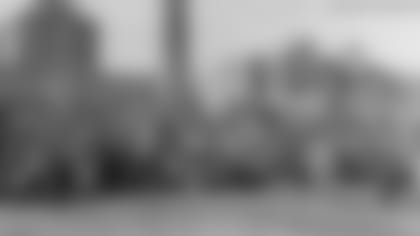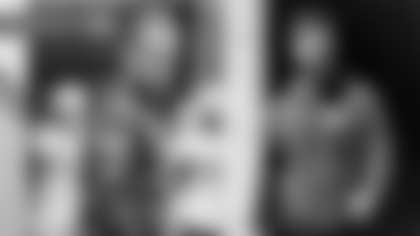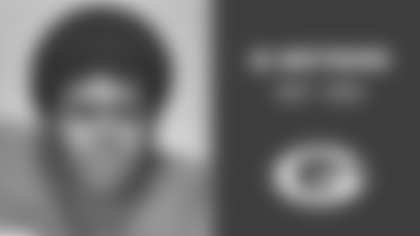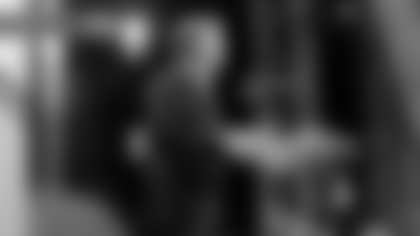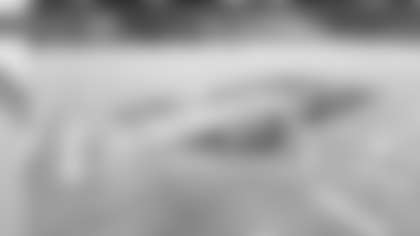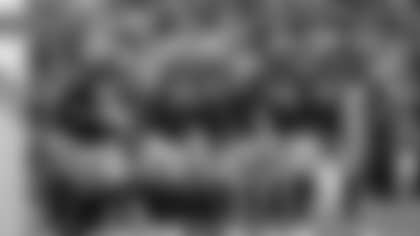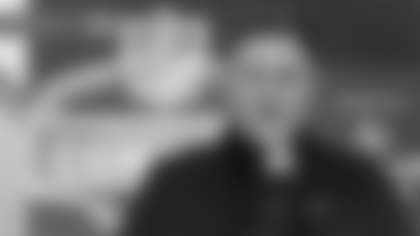*Cliff Christl started gathering oral histories with former Packers and others associated with the team in 2000 and will continue to gather them as Packers historian. Excerpts from those interviews will be periodically posted at **www.packers.com*.
The late Ken Kaye literally grew up with the Packers, attending his first game in 1919, the team's first season. Born in 1911, he was eight years old at the time and lived just down the block from Hagemeister Park, the Packers' original home. He remained a fan into the 21st century.
On his memories of those earliest games: Kaye –"It was almost like a frontier thing. I remember the Green Bay people here would get so angry that if they saw an opposing player making a run they'd go out and tackle him. It wasn't prevalent, but I saw it happen. Who would believe it?"
On his memories of the early players: Kaye –"You had guys that were all game. They were getting nothing or maybe five bucks a game. I used to see those guys bloodied, no doctors on the sidelines. And they played the whole game back and forth."
On his memories of Curly Lambeau as a player: Kaye – "Terrific. In my hazy past, when I think of a footballer, Curly really had it. You know the story. He went to Notre Dame one year. Notre Dame's colors were blue and gold. I can still see Curly with that ND on his sweater. He came home after one year. Things were so simple in those days; you can't equate it with today's society. Curly didn't go back to Notre Dame because of tonsillitis. Did you ever hear such a ridiculous story? But it was true. Embedded in that healing was you had to help your folks or whatever. I'm sure that was Curly. So he went to work for Acme Packing Company (actually Indian Packing), a meatpacking company. But remember he's only 18 (actually 21) years old. He got uniforms and got the Packers started. Then three years later, he has them in the NFL. Isn't that quite a story?"
More on Lambeau: Kaye –"My favorite Packer would have to be Lambeau in the early days. He was a kid who started a football team and he could play. He was a great passer. And above all, the guy was good looking. He had unbelievably curly hair. He was built like a million bucks. Do you know he was good on stage as a singer? They used to have the Minstrels at the Orpheum (Theater). Curly was a part of that… If you want to picture a made-for-movie hero, you'd have to have a Curly Lambeau."
On whether Lambeau's reputation as a ladies man was warranted: Kaye –"Oh yeah. You know, when Curly became good, Green Bay was jealous. They wanted to hang his (butt). He was a philanderer. I remember his (first) wife at Curly's funeral. I spoke to her for quite awhile. You see Curly left her for Hollywood. But she was a strong woman. Her name was (Marguerite) Van Kessel. They had that grocery store on Monroe (Avenue) right near Cathedral. John was a grocer and (Curly's) wife was the daughter of John."
On the location of Hagemeister Park, a large public park on Green Bay's east side: Kaye –"When you go down Walnut Street and get to Baird (Street), straight ahead to the east and south was the original Hagemeister Park. In my youth, it extended from the East River to where the (old Joannes Park) swimming pool was on the south end. See, Hagemeister Park had the bandstand, the racetrack, the Clubhouse, the Armory, all these things."
On the location of the Packers' original playing field within Hagemeister Park, the team's home field from 1919-22: Kaye –"Right where Walnut Street hits Baird, right to the immediate left would be the old (Hagemeister) Clubhouse, a big, wooden building. That's where the sports society congregated in Green Bay. I remember my dad would take me by the hand and say, 'OK, we're going to go over and watch the (baseball) game for a while.' Later on, when the Packers were born, there was a makeshift field there that was pretty much where (East) high school is now. That's where they first built some stands for the people. But when I say stands, it was an abbreviated deal. There wasn't much there."
On how fans got to the games in the early years: Kaye –"Street cars. They walked. Remember in 1919, when the Packers were born, very few people had a car."
On whether early fans might have ridden horses to the games: Kaye –"I wouldn't be a bit surprised. When I first went to a Packer game there were no stands. They used to have a rope to keep people off the field. But there used to be a lot of belligerent and enthusiastic fans and they'd end up tackling the damn opposition. This was very crude football. I'm not kidding you. This is not a fantasy."
On whether he remembered fans driving up to the playing field and watching games from their cars: Kaye –"No. Up until even in the 1920s, very few ordinary people owned a car."
On whether he remembered Packers fans helping build the first fence around the playing field at Hagemeister Park in 1920: Kaye –"No, but I remember when the Packers started out that they didn't have a grandstand. Everybody stood on their feet in a roped off area around the gridiron. Do you know who built the first stands? Marcel Lambeau (Curly's father)."
On the Hagemeister Park Armory, the Packers' first clubhouse and first indoor practice facility back in the early 1920s: Kaye –"It was one block north of the Clubhouse and the entrance faced south. It didn't face Baird. I lived at 517 Pleasant Street (now part of Baird), a half block off Three Corners. As the crow flies, I was about 1,000 feet from where the Packers were born. But we're talking about the Armory. That was the sports arena in Green Bay and they had no central heat. I don't think they even had showers. They had something like bathing tubs. But it was so damn cold."
On whether the players dressed at the Armory in the early 1920s: Kaye –"I think the Packers traveled around town in a chain-driven truck. It was a flatbed truck. But you could see the propulsion of the wheels with a big chain. I don't know if the Packers were picked up at their homes or whatever, but I remember that flatbed truck and the Packers lying on that truck. They'd come into where they were playing football, but where they came from I don't know, whether it was their own homes or hotel rooms. But I remember I used to see a lot of these guys in the vicinity of the old Armory lying on the flatbed truck. Whether it was before the game or after, I can't remember."
On fans gathering in the days before radio at large halls in Green Bay to follow the results of road games sent via Western Union from the site of the game and announced through a megaphone or presented on a large board called a Gridgraph: (Kaye said he started attending the play-by-plays at Turner Hall in 1921, the Packers' first year in what is now the NFL.) Kaye --"It was technology of the day we couldn't believe. They had a big board up there. When I look back at the communications of that time, it was simply fantastic. I used to chuckle. A guy would stand behind the board and he would get the type over the Teletype system or whatever it was. He would place the ball like on a wire. Yes, I saw the Grid-O-Graph right from the start. It was on a wire and if there was a ball, they'd jiggle the ball. You couldn't believe it. The fans would cheer. Oh sure, just like they were there in person. There was nothing like it."
More on the Gridgraph: Kaye –"Before that -- in what was old Legion Park -- they used to have the World Series games. You see I moved downtown when my dad got a job as janitor and lived at the Lazarre Apartments, which were razed in the last few years. They were across from the Press-Gazette, and Legion Park was about a block away from where I lived. So I used to go there and watch the World Series. Then almost simultaneously at Turner Hall, which was a block east from where I lived -- a big wooden building -- is where they showed the Packers games."
On Bellevue Park, the Packers' home from 1923-24: Kaye –"That was a baseball park originally. In fact, I played there myself. The bridge is still there and there was a little creek there. You know where McDonald's (restaurant) is? Right about there. In fact, if you sat in the stands, you could bend back and look at the street about 10 feet away. Main Street. That was Bellevue Park. Right over the left field wall, which was north, was the old Acme Packing Company."
On his memories of old City Stadium when it first opened with about 5,000 seats: Kaye –"The first game was 1925 and I saw that game. I remember the fences were so easy to get over that we did that all the time. They'd look the other way and let the kids climb over."
On Verne Lewellen, a star back and punter from 1924-32: Kaye –"He was the greatest punter I ever saw in my life. When the football was built like a pumpkin, his best punts came when he was in his own end zone or near the end zone. He used to punt that ball 80 yards down the field -- not rolling -- in the air. He was tremendous. Why he isn't in the Hall of Fame is beyond me."
On Hall of Famer Johnny Blood: Kaye –"He was more flakey on the field, but a tremendous athlete. A lot of times he was drunk, you know. Lewellen was a more serious athlete. John was so good that he could get drunk and play the game. Even the people knew off hand he was drunk out there."
On his memories of tending bar after World War II at the Log Cabin across the side street from the Packers office building on Washington Street: Kaye –"(Gene) Ronzani used to come over and when he got drunk enough at night rave about the Bears. And when he was drinking, he used to strut around. He was very important to himself. Scooter McLean used to play cribbage. Half the day, he'd come in there. He wasn't much of a drinker. That was before Scooter became head coach." (Ronzani served as the Packers head coach from 1950-53. McLean served as an assistant from 1951-57 before becoming head coach in 1958.)
On being a Packers fan since 1919: Kaye –"I know my close friends, none of us had any idea that it would go beyond the East River as far as the Packers are concerned. At 92 (in 2003), I think I'm the last of an era that had any interest in the Packers, let alone be a fanatic."
Kaye died in 2006 at age 95. The above excerpts were taken from two interviews conducted in 2003 and another in 2005.



